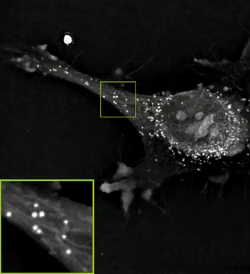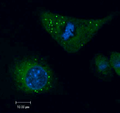This article may be too technical for most readers to understand.(March 2015) |
Lipid droplets, also referred to as lipid bodies, oil bodies or adiposomes, [1] are lipid-rich cellular organelles that regulate the storage and hydrolysis of neutral lipids and are found largely in the adipose tissue. [2] They also serve as a reservoir for cholesterol and acyl-glycerols for membrane formation and maintenance. Lipid droplets are found in all eukaryotic organisms and store a large portion of lipids in mammalian adipocytes. Initially, these lipid droplets were considered to merely serve as fat depots, but since the discovery in the 1990s of proteins in the lipid droplet coat that regulate lipid droplet dynamics and lipid metabolism, lipid droplets are seen as highly dynamic organelles that play a very important role in the regulation of intracellular lipid storage and lipid metabolism. The role of lipid droplets outside of lipid and cholesterol storage has recently begun to be elucidated and includes a close association to inflammatory responses through the synthesis and metabolism of eicosanoids and to metabolic disorders such as obesity, cancer, [3] [4] and atherosclerosis. [5] In non-adipocytes, lipid droplets are known to play a role in protection from lipotoxicity by storage of fatty acids in the form of neutral triacylglycerol, which consists of three fatty acids bound to glycerol. Alternatively, fatty acids can be converted to lipid intermediates like diacylglycerol (DAG), ceramides and fatty acyl-CoAs. These lipid intermediates can impair insulin signaling, which is referred to as lipid-induced insulin resistance and lipotoxicity. [6] Lipid droplets also serve as platforms for protein binding and degradation. Finally, lipid droplets are known to be exploited by pathogens such as the hepatitis C virus, the dengue virus and Chlamydia trachomatis among others. [7] [8]
Contents
Cells need to adjust the size and structure of their organelles to keep up with growth and changing environmental conditions. To do this, they either make new phospholipids—the main components of organelle membranes—or modify their fatty acid (FA) content. Fatty acids are also used to produce triacylglycerols (TGs), which store energy in structures called lipid droplets. [9] The synthesis of triacylglycerols (TG) can be occurred through two different enzyme pathways. Diacylglycerol Acyltransferases (DGATs) like Dga1 are enzymes found in most eukaryotes. They add an acyl group from a fatty acid that has been activated with coenzyme A (FA-CoA) to diacylglycerol (DG), forming TG. Phospholipid-Diacylglycerol Acyltransferases (PDATs) are enzymes primarily found in fungi, microalgae, and plants. PDATs like Lro1 in yeast transfer a fatty acid directly from a phospholipid to DG to form TG. Moreover, Lro1 couple TG synthesis with the deacylation of membrane phospholipids (PL), resulting in the formation of TG and lysophospholipids (LPL). [10]
When nutrients become available, the yeast cells enter the exponential growth phase (EXP) to grow quickly. It has been shown that during the EXP phase, Lro1-GFP is localized in the endoplasmic reticulum (ER) to synthesize triacylglycerols (TG), which are essential for phospholipid synthesis. [9] However, when nutrients become scarce, the cells enter the post-diauxic shift (PDS) phase and Lro1-GFP no longer is in the ER. Instead, it moves to a specific area of the nuclear envelope. This relocation suggests a shift in Lro1's role, possibly in response to the stress of nutrient depletion. Furthermore, this movement is influenced by signals from the cell cycle and nutrient availability, and it stops when the nucleus grows larger. [9]
Two approaches were used to investigate whether Lro1 can access the inner nuclear membrane (INM). [9] In yeast, the ability of integral membrane proteins to move from the endoplasmic reticulum (ER) to the inner nuclear membrane (INM) is restricted by the size of their cytosolic domains. Proteins with cytosolic domains larger than 90 kDa cannot pass through the nuclear pore complex into the INM. It has been shown that when the Lro1's N-terminal domain was enlarged with one, two, or three copies of the maltose-binding protein (MBP), its ability to target the nucleolus was significantly reduced. This suggests that Lro1 normally resides at the INM, but when its N-domain becomes too large, it can no longer pass through the nuclear pore complex to reach the INM and these larger proteins are likely being degraded. [9]
The anchor-away technique was used as the second approach. The researchers fused the INM protein Heh1 with FK506 binding protein (FKBP12) to serve as an anchor at the INM and interact with other proteins. Lro1 was fused to GFP for visualization and the FKBP12-rapamycin-binding (FRB) domain. This fusion enables Lro1 to interact with Heh1 at the INM in the presence of rapamycin. FRB-GFP construct contains GFP fused to the FRB domain but without Lro1, to show the specific effects of Lro1's presence and used as a control. [9] Upon the addition of rapamycin, FRB-GFP quickly (within 30 minutes) changed from a diffuse distribution to a ring-like pattern, indicating that it had been recruited to the INM by Heh1-FKBP12. This ring-like localization confirmed that the INM anchor (Heh1) is accessible to FRB-GFP. In the strain expressing FRB-Lro1-GFP, rapamycin treatment caused a loss of Lro1's cortical ER localization and its accumulation at a perinuclear ring, which is characteristic of INM proteins. This suggests that Lro1, via its N-domain, can indeed associate with the INM. In contrast, when Lro1's N-terminal domain was enlarged by adding 3xMBP, the fusion protein retained its localization at the cortical ER even after rapamycin treatment. [9]
The nuclear membrane near the nucleolus tends to expand when there's excess phospholipid synthesis. It has been investigated that whether the protein Lro1 is catalytically active to produce triacylglycerol (TG) in this specific membrane area. [9] To test Lro1's activity, the researchers expressed it in a yeast strain that couldn't produce any neutral lipids on its own. They did this by deleting four key enzymes involved in lipid production: the DG acyltransferases (LRO1 and DGA1) and the steryl acyltransferases (ARE1 and ARE2). This mutant strain, called "4D," lacks neutral lipids and lipid droplets (LDs), making it ideal for studying Lro1's function. [9] The mutant "4D" yeast cells cannot survive under nutrient-poor conditions because they cannot make triacylglycerol (TG) or lipid droplets (LDs), which are essential for survival during this phase. When Lro1 is reintroduced as the only enzyme capable of producing TG, it rescues the cells, allowing them to survive better during the stationary phase by forming lipid droplets. [9] Moreover, Lro1 with a mutation in the conserved lipase motif cannot perform its catalytic function, meaning it cannot produce TG. As a result, these cells also fail to survive in PDS, similar to the cells without any functional Lro1, demonstrating that the catalytic activity of Lro1 is crucial for survival and LD formation. [9]
These findings [9] suggest that Lro1's activity in the nucleus creates a local site for TG synthesis, which helps reshape the nuclear membrane as needed. [9]


